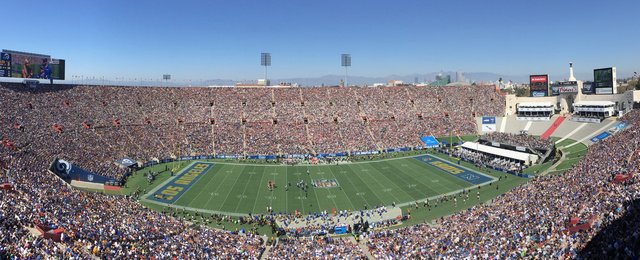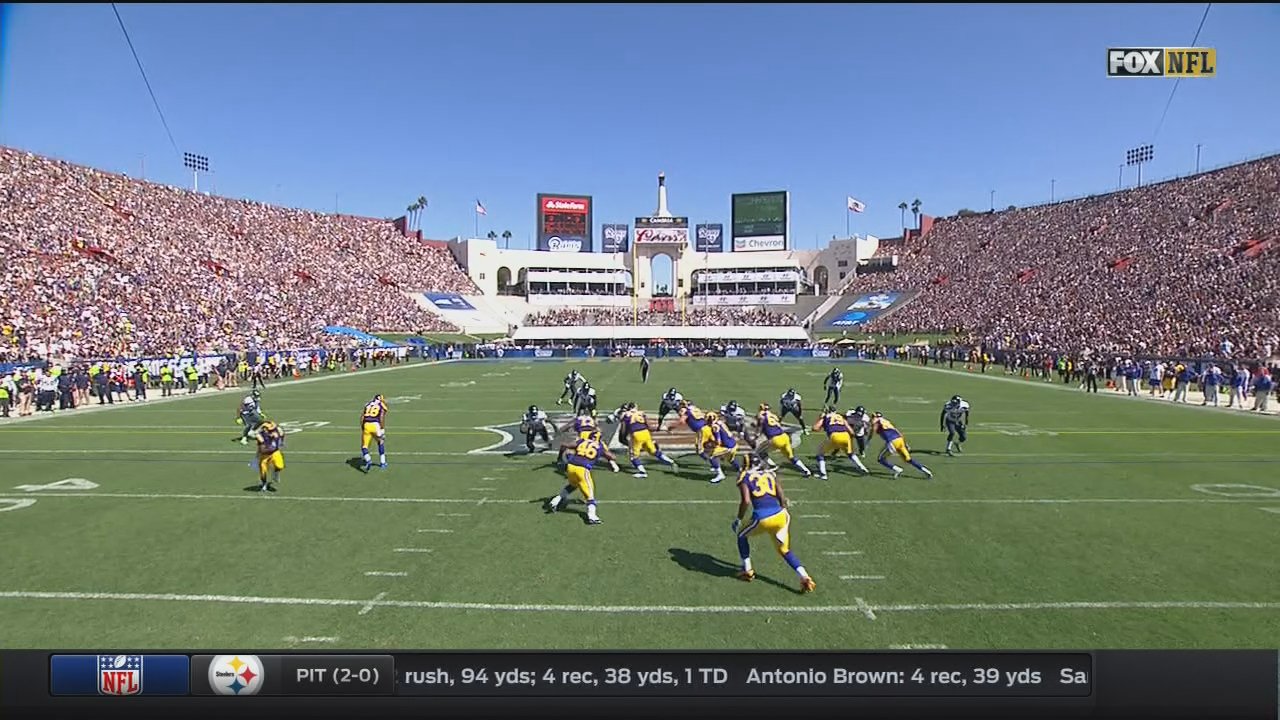http://deadspin.com/proposed-las-vegas-raiders-stadium-would-cost-taxpayers-1782554525A proposed Las Vegas Raiders stadium would cost taxpayers a record $750 million.
A proposal by 22nd-richest man in the world, casino magnate and owner of the Las Vegas Review-Journal, Sheldon Adelson, would fund a domed stadium in Las Vegas with $750 million in municipal bonds. According to Bloomberg, that would be a new record for public contributions to an NFL stadium, surpassing the $620 million in tax money that went to build Lucas Oil Stadium in Indianapolis.
There is an alternate proposal, supported by the Nevada Governor’s economic adviser, that would require “only” $500 million in public funds. The Southern Nevada Tourism Infrastructure Committee is studying the proposals, and is expected to issue its recommendations next month.
Here is the part where a pro-stadium person runs to the comments and says “Hey, wait, the $750M in bonds will be paid back by an increased hotel tax. As a Las Vegas resident, this won’t cost me anything!” And here’s the part where we note, for the 750 millionth time, that tax money is fungible. If the legislature approves a hotel tax hike, that money could go to literally anything—even things that are actually useful to a local economy. (The committee currently has on its desk proposals to fund transit improvements and an expanded convention center.)
You are using an out of date browser. It may not display this or other websites correctly.
You should upgrade or use an alternative browser.
You should upgrade or use an alternative browser.
NFL votes to move the St. Louis Rams to Los Angeles for the 2016 season
- Thread starter RBH
- Start date
- Status
- Not open for further replies.
Lactose_Intolerant
Member
You don't get rich by paying for stuff yourself.
http://www.vcstar.com/sports/nfl/ra...d5-e7db-5eb1-e053-0100007fdb51-384159191.htmlThe Los Angeles Rams have already sold 63,000 season tickets, just 7,000 short of their planned cap, according to Demoff. The plan is for a capacity of 80,000 at the Coliseum, extended to 90,000 "for a few special games."
Here you go Stan, take our money. We don't care if you win.
It's a match made in heaven.
ryutaro's mama
Member
I was told that our city couldn't support an NFL team tho. <rolls eyes>
http://justblogbaby.com/2016/06/23/oakland-raiders-disappointed-by-las-vegas-funding-cut/Thursday was a good day for the City of Oaklands fight to keep the Oakland Raiders as the franchise came out of a ruling from the Southern Nevada Infrastructure Committee disappointed with a reduction of public funding to $550 million (something that could potentially sour owner Mark Davis on the idea of relocating the franchise to Las Vegas).
Raiders President Marc Badain publicly commented on the ruling to decrease the public contribution from what was hoped to be $750 million to $550 million. Badain stating that the franchise is disappointed by what they heard on Thursday, going as far as to say that the NFL will look negatively at the decreased taxpayer contribution to build a potential 62,000 seat domed stadium in Vegas.
Regardless of the Raiders disappointment with todays decrease of public funds in Vegas, the question will be if the $550 million that was approved will be enough to warrant a relocation. With Davis still waiting for progress in Oakland, there is a good chance that Vegas could still be a major player in the Raiders stadium saga even after decreasing $200 million from the pot. Time will tell, but as of Thursday it is looking like the love affair between the Raiders and Las Vegas is headed on the rocks for a little while.
Freyjadour
Member
I was told that our city couldn't support an NFL team tho. <rolls eyes>
Let's not get ahead of ourselves here, the Rams have yet to lose their first game in LA this go around.
http://www.sandiegouniontribune.com/news/2016/jun/23/demaio-stadium-alternative/Former City Councilman Carl DeMaio will unveil a plan today to pay for a new $1.5 billion Chargers stadium without a tax increase or a convention center annex.
DeMaio, who ran unsuccessfully for mayor in 2012 and Congress in 2014, said the proposal involves fans and investors, investing in the stadium for $5,000 to $700,000 each.
Instead of a convention center annex, as the Chargers propose in their planned Nov. 8 so-called convadium ballot initiative, DeMaio would substitute a 250-room hotel whose rooms would overlook the stadium field, and a 200,000-square-foot retail center with a fitness club, nightclubs, shops, restaurants and other attractions.
In addition to laying out his vision, DeMaio said he will encourage local hoteliers to move immediately for their own ballot initiative to authorize the convention center expansion already approved by the California Coastal Commission, and a separate measure, if necessary, to fund the project.
If they are worried about the convadium not being beneficial to San Diego, why are they sitting on their hands? DeMaio asked. Get up and start moving forward. What I want to see is leadership in town. The only people providing leadership right now are the Chargers. Whose fault is that?
To get the plan enacted, DeMaio proposes a mail ballot election on Nov. 15 that would delete the Chargers proposed financing plan but retain the general concept of a sports and entertainment center immune to environmental legal challenges.
However, he also said the plan would work with a stadium rebuild at the current Qualcomm Stadium site or on a portion of the San Diego Unified Port Districts Tenth Avenue Marine Terminal, linked by a people mover to the San Diego Convention Center.
DeMaio, now a talk show host, said he was moved to come up with his own plan because no other plan has been advanced with the taxpayers interests in mind.
None of these options have been discussed in the context of a San Diego solution, DeMaio said in an interview Wednesday. The Chargers have their solution and I dont fault them for developing a position that is very favorable to their interests.
The Chargers initiative relies on raising the current city hotel room tax from 12.5 percent to 16.5 percent, $650 million from the team and NFL and other sources that could underwrite a $1.8 billion, publicly owned facility with 65,000 seats for a stadium and an attached convention exhibit hall, meeting rooms and ballrooms that can expand to the stadium field.
The county registrar of voters expects to complete a preliminary review by July 10 of the 110,786 signatures the team has collected. If a sample check indicates a shortfall in the 66,447 signatures needed, additional time will be needed to complete a more thorough count.
The financial sources could include:
▪ $300 million from FanLord shares, ranging from $5,000 for limited-access standing-room-only to $700,000 per suite. In return, investors would stand to receive discounts to stadium events and a share in any profits.
▪ $200 million from a boutique hotel development partner with $62.5 million for the hotel and the remainder set aside for the stadium.
▪ $300 million from a retail partner with $60 million for the retail portion and remainder for the stadium.
▪ $300 million from the NFL loan already promised to the Chargers.
▪ $150 million from the Chargers in the form of an equity share in the project or lease payments.
▪ $150 million from naming rights that go to the project and not to the Chargers, as the teams proposed financing package envisions.
If the project is built in Mission Valley, San Diego State University and UC San Diego would contribute $125 million rather than build their own, smaller facility that could do double duty as a Major League Soccer venue.
A Mission Valley development partner would contribute up to $200 million in return for development rights at the 166-acre Qualcomm site.
If the facility is built on the 10th Avenue Marine Terminal, the port would contribute $100 million.
To cover infrastructure improvements, $50 million would come from property taxes generated by the hotel and retail development.
BFIB
Member
Just wait until you see what type of organization Kroenke runs. You won't want to support it.I was told that our city couldn't support an NFL team tho. <rolls eyes>
I was told that our city couldn't support an NFL team tho. <rolls eyes>
Its new and exciting. Give it a couple years
By 2019 Fisher will have a life long contract,

http://www.sfgate.com/raiders/article/San-Diego-voters-to-decide-fate-of-Raiders-8351039.phpSan Diego voters will decide in November on the Chargers’ proposal to raise local hotel taxes for a downtown stadium and convention facility — a vote which might, if approved, open the door for the Raiders to move to the Los Angeles area.
City Clerk Liz Maland announced Saturday that the Chargers had secured enough valid signatures to qualify the measure for the 2016 ballot.
The Chargers have been approved by NFL ownership to join the Rams in a stadium being built in Inglewood. If the Chargers do not move there, the Raiders would be OK’d to move there.
Raiders owner Mark Davis has said his preference is to move the team from Oakland to Las Vegas, where a stadium initiative is being considered.
Chargers Chairman Dean Spanos expressed appreciation to those who signed petitions. “We gathered more than 110,000 signatures in less than six weeks, an extraordinary result that demonstrates the high level of community interest in a new multiuse stadium and convention-center facility downtown,” Spanos said.
The initiative would raise the city’s tax on hotel stays from 12.5 percent to 16.5 percent to pay for a $1.8 billion stadium and convention center in downtown’s East Village, next to Petco Park, the San Diego Union-Tribune reported.
The Chargers would contribute $650 million for the stadium portion of the project, using $300 million from the NFL and $350 million from the team, licensing payments, sales of “stadium-builder” ticket options to fans, and other private sources.
The city would raise more than $1.1 billion by selling bonds that would be paid back with the higher hotel tax revenues. That $1.1 billion would cover the city’s $350 million contribution to building the football stadium, $600 million to build the adjoining convention-center annex, and $200 million for land, the newspaper reported.
A coalition of opponents that includes politicians, business organizations and neighborhood groups has vowed to defeat the initiative.
Mayor Kevin Faulconer, a Republican, has raised many questions about the measure, but he hasn’t yet taken a position.

http://www.turfshowtimes.com/2016/7...-and-football-e-network-fall-2016-hard-knocksAccording to Variety, the Los Angeles Rams - in addition to HBOs Hard Knocks, can be seen on a showed called "Hollywood & Football" this fall on E! Network.
It will feature six hour-long episodes later this year, coinciding with the NFL season.
Jeff Olde, EVP of E!s programming and development had this to say about the show, which focuses on the Rams players and their families as they transition from St. Louis to Los Angeles:
"We are excited to take viewers inside the exclusive lifestyles of these top athletes and their families as they navigate a new city, new friendships, new schools and the inevitable Hollywood gossip. E! has a track record of success with pop culture programming centered in the world of sports, and this series will capture the off the field perspective of one of footballs most anticipated and high profile events as the Rams return to L.A."
Rams players and wives/significant others to be featured on the show are: Kenny and Sabrina Britt, Rodger and Asia Saffold, Lance and Danielle Kendricks, Chase and Kila Reynolds, Cory and Bianca Harkey, and Bradley Marquez and his pregnant fiancee Melissa.
New trailer for HBO's Hard Knocks with the Los Angeles Rams:
https://www.youtube.com/watch?v=Ab2K73um96s
https://www.youtube.com/watch?v=Ab2K73um96s
Ninja Scooter
Member
Rams remove white trim from their jerseys:


It's an improvement but they need to go back to the classic colors.
It's an improvement but they need to go back to the classic colors.

tiggerkiddo
Member
Not that classic though.
http://losangeles.cbslocal.com/2016/07/25/los-angeles-rams-preseason-ticket-prices-nfl-2016/After years of speculation and planning, the Rams, formerly based in St Louis, have officially moved to their new home in Los Angeles. Fans are gearing up for the return of football to LA for the first time since 1979, driving demand high for preseason tickets.
As of July 22, the Rams two preseason games have the second-highest combined median price at $123. The highest combined median preseason price in the league belongs to the Seattle Seahawks at $143.
On Aug. 13, the Rams will host their preseason opener against the Dallas Cowboys at Los Angeles Memorial Coliseum. The current median price for that game is the highest of any individual preseason game at $180, with a get-in of $97. Fans looking for more of a bargain might consider attending the game on Aug. 20, when the Rams face the Kansas City Chiefs. The median price for that matchup is $90, with just $30 to get in the stadium.
Rams fans in Denver can catch their team on Aug. 27, when the Rams play the Broncos. The median price for that game is $106, with a get in price of $41.
The Rams final preseason game will take place on Sept. 1 against the Minnesota Vikings in Minneapolis. Fans can get in for just $29, while the game has a median price of $73.
http://espn.go.com/mlb/story/_/id/17026653/new-ballparks-tampa-bay-rays-oakland-needed-mlb-expansionThe Athletics' search for a new ballpark will be confined to Oakland, and Major League Baseball will put off any expansion talks until it solves its two outstanding stadium issues.
Baseball commissioner Rob Manfred said Tuesday the exact site is up to the team's owners, but he made clear the sport has no intention to allow a move outside the city.
"I am committed to Oakland as a major league site," he told the Baseball Writers' Association of America on Tuesday. "I think that if we were to leave Oakland, I think 10 years from now we would be more likely than not looking backwards saying we made a mistake."
Unhappy with the Oakland Coliseum, which opened in 1966, the A's considered building a ballpark in the southeast Bay Area city of Fremont and then scrapped that plan in 2009. They hoped to move to San Jose but were blocked by the San Francisco Giants, whose territory includes that Silicon Valley city.
"I think that Oakland is more likely than not to be a better market five years from now than it is today," Manfred said. "So I certainly have not given up on Oakland."
Manfred said the A's should go ahead with their stadium efforts, independent of the NFL's Oakland Raiders, who also want to leave the Coliseum for a new facility.
The Tampa Bay Rays also want a new ballpark, and were given permission by the St. Petersburg City Council to search for sites in the area outside the city.
Manfred said any move to add teams beyond the current 30 must wait because of the stadium searches.
"Both of those clubs need new major-league-quality facilities," he said, "and until that's resolved, I think expansion has got to be on the back burner for us."
http://espn.go.com/blog/nflnation/p...d-to-rule-on-voting-for-chargers-stadium-planSAN DIEGO -- According to San Diego city attorney Jan Goldsmith, the determination of whether the San Diego Chargers need two-thirds or a simple majority of votes for approval of the teams stadium plan in November could be delayed until December or later.
In order to speed up that process, Goldsmith wrote a letter to the California State Supreme court this week, asking them to expedite a decision on the city of Uplands appeal that classified citizens initiatives as simple majorities.
According to California state law, measures requesting an increase of a special tax for a single purpose in local government require a two-thirds vote.
Goldsmith said his office will put the Chargers initiative on the ballot at two-thirds, a painstakingly high bar for the team to reach in order to build a new stadium downtown.
Lets say 55 percent of the public says Yeah, lets go have a downtown stadium, Goldsmith said. And you say, Well, it requires two-thirds. And then you hear later from the Supreme Court that it only requires a majority vote. You dont want to lose your team like that. And thats what Im trying to avoid. Thats not right.
Goldsmith said his office has to make a determination for the November ballot by Aug. 12 in order to get it into voters pamphlets in time. As it stands now, Goldsmith said his office will key the measure in at two-thirds, with the caveat that according to the Supreme Court, it could be less.
Goldsmith said the city would need a decision from the Supreme Court by early December to certify whether the measure passed or failed. Should a ruling not be made by this date, Goldsmith asked the Supreme Court to take jurisdiction over the Chargers' initiative and The Citizens Plan if both get better than a simple majority but do not reach the two-thirds threshold.

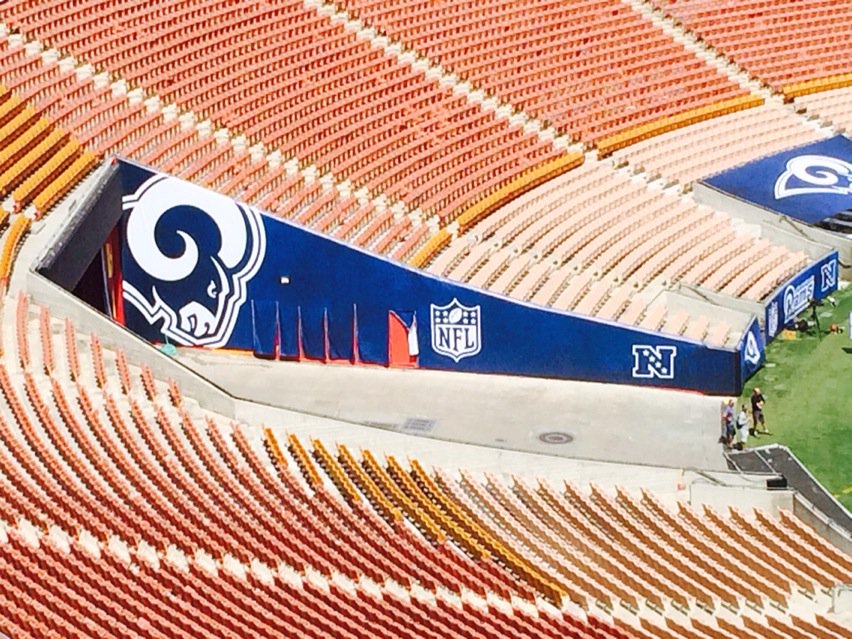


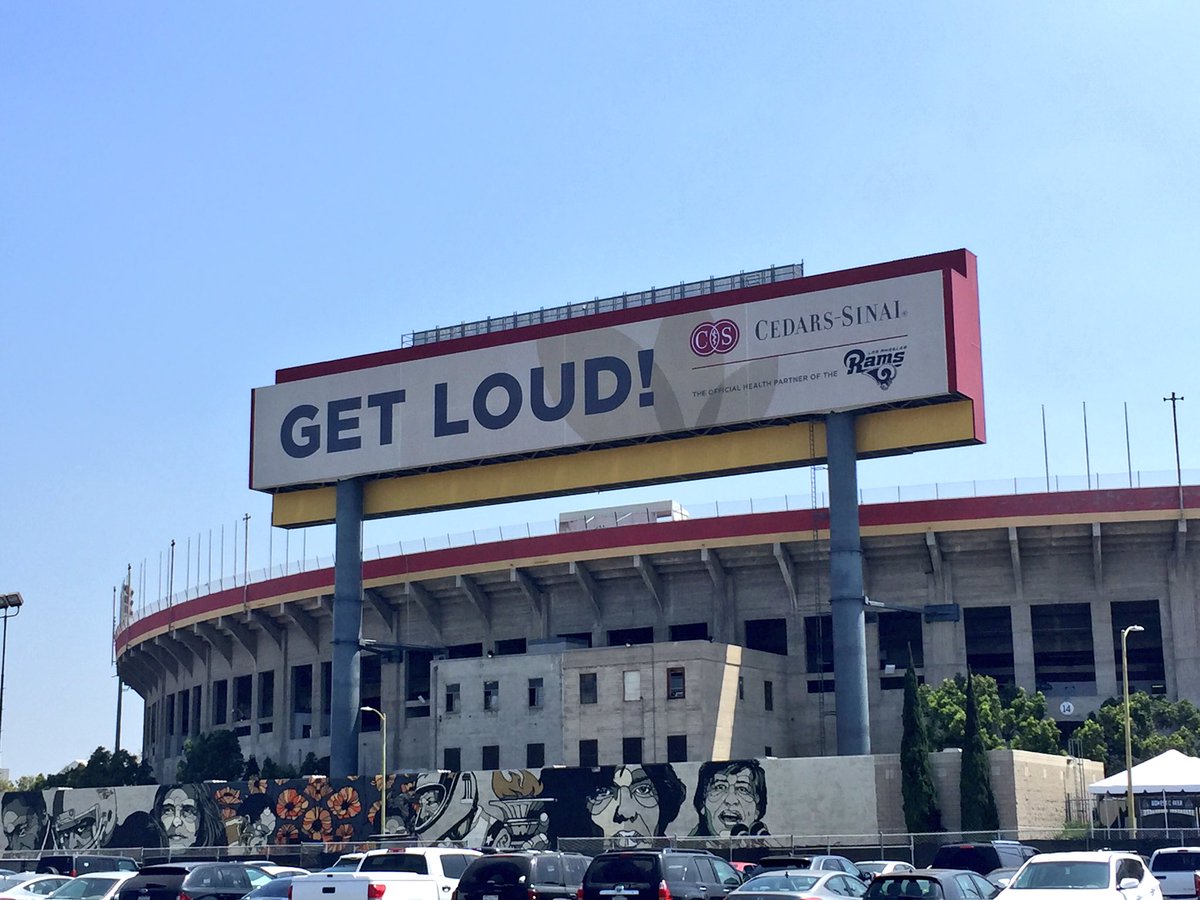

http://www.espn.com/blog/st-louis-r...turn-to-coliseum-for-scrimmage-saturday-nightLOS ANGELES -- There are several steps in this process of moving an NFL team from one city to another.
Big steps, small ones, memorable ones, and most definitely some that are looked more forward to than others.
Saturday will bring the latter when the Los Angeles Rams make their first team appearance back in the Coliseum they once -- and will again this season -- called home.
The Rams are taking a break from their summer camp at UC Irvine to hold a special practice and mini-scrimmage at the Coliseum that is open and free to the public. Theyre calling it their first annual family day, and it will be filled with firsts for players, most of whom have never stepped foot in the legendary stadium.
When its all said and done, I want it to be a great experience for the fans, a great experience for our staff and organization, and most of all, a productive day for our players, said Rams head coach Jeff Fisher.
Fisher knows the 93-year-old Coliseum well, having played in it as a defensive back for USC. Fisher said hes been back since and toured the site of two Olympics.
The first time down the tunnel was pretty cool, he said.
The Rams have one current player, T.J. McDonald, who went to USC and several others from Pac-12 schools who played there as collegians. None have played their professionally. The Rams left the Coliseum for Anaheim Stadium in 1980 and Anaheim for St. Louis in 1995, the same year the Raiders left the Coliseum for Oakland.
Now the Rams are going home again and are scheduled to play in the venerable Coliseum for the next three years until their new stadium is completed in Inglewood.
Its that next step in the progression with respect to the move, Fisher said.
Fisher said players are excited about their first appearance in the Coliseum.
Weve been talking about it for a week or so now, just giving them little details on parking and locker rooms and family and friends," Fisher said. "The organization has done a good job of setting it up. I think youll be really impressed by it.
Fisher said the players will be in full pads and the team will use an eight-man officiating crew. He said it will be a typical team practice, but that rookies and young players will play a short scrimmage at its end.
We dont tackle and bring people to the ground out here in a normal practice, but (Saturday) in this particular 12-to-14 play session, were going to, he said.

http://www.nfl.com/news/story/0ap30...os-angeles-rams-will-feature-hollywood-flavorHard Knocks: Training Camp with the Los Angeles Rams" is set to debut this Tuesday at 10 p.m. ET on HBO. The weekly five-show series, which runs through Sept. 6, will document the preparations for the Rams' historic return to Los Angeles after moving from St. Louis.
This "Hard Knocks" will have a distinct L.A. vibe, according to Ken Rodgers, the coordinating producer for NFL Films. He even puts on a Hollywood director's hat in describing the tone.
"The Rams' arrival in Los Angeles is the overarching storyline of the entire series this year," Rodgers said. "In my mind, this is the classic story of a Midwestern boy moving west to make his dreams come true. He's going to discover the bright lights of L.A. Only instead of one boy, it's a team of young men trying to make it big."
https://twitter.com/RamsNFL/status/764530039786352640?lang=enApproaching 90k tickets sold for tonight's Cowboys vs. Rams game
Will be the most attended NFL preseason game in U.S. history #DALvsLA

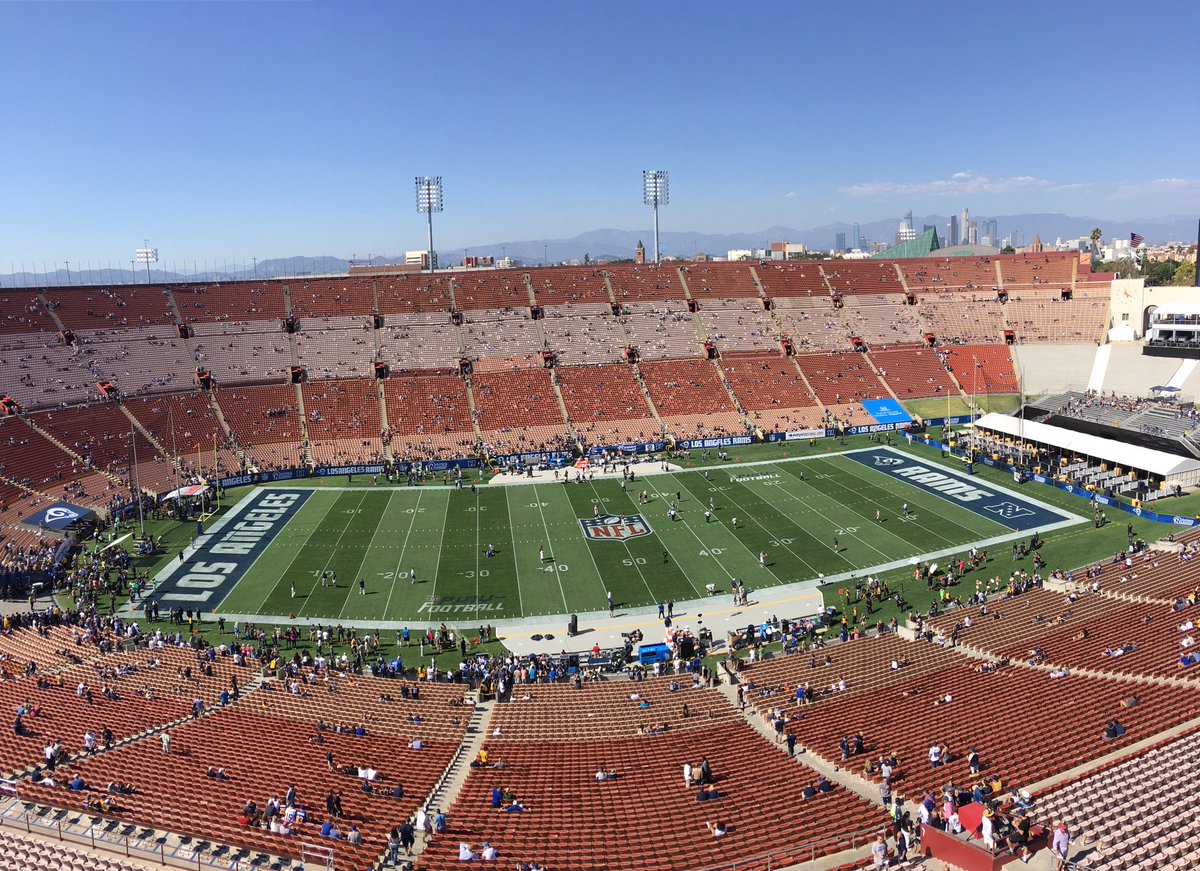
Are they really gonna fill up the Coliseum for preseason? I would be impressed if they did.
Also shame that USC's renovations aren't going to be completed any time soon. The coliseum renderings look very nice and I'm excited to see it become a modern stadium
http://deadspin.com/raiders-apply-f...source=deadspin_twitter&utm_medium=socialflowRaiders apply for "Las Vegas Raiders" trademark, release stadium renderings
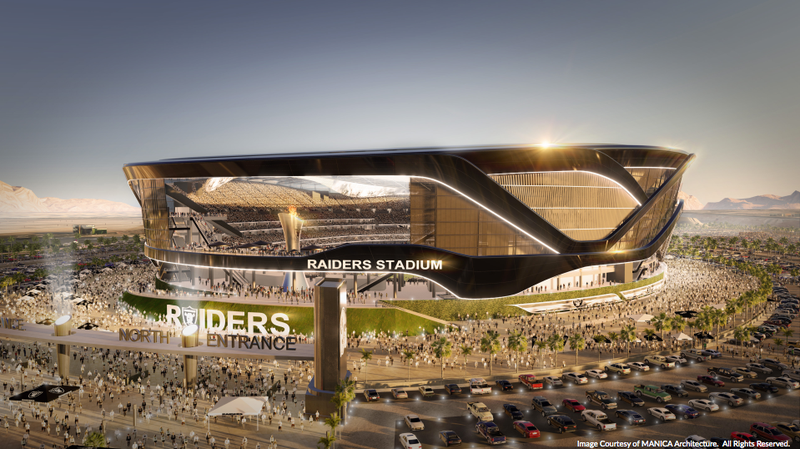
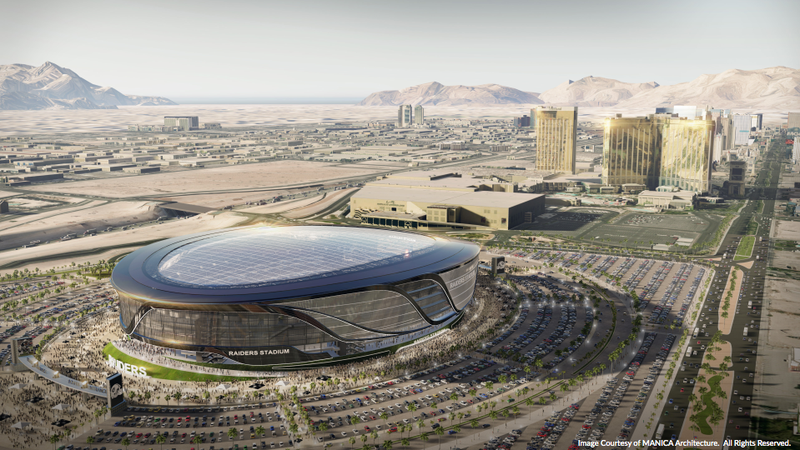
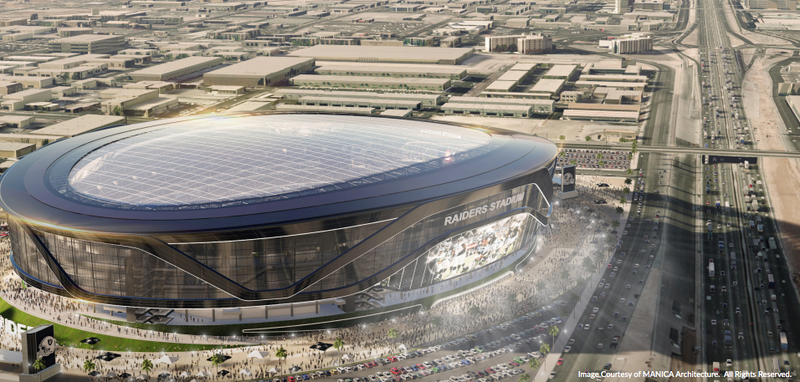
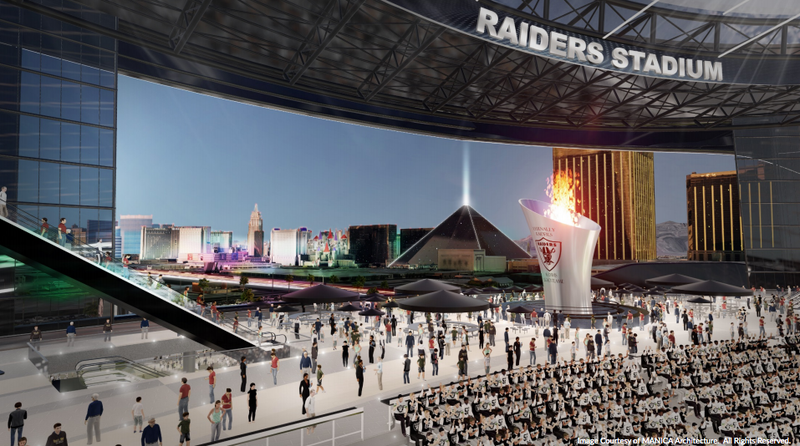


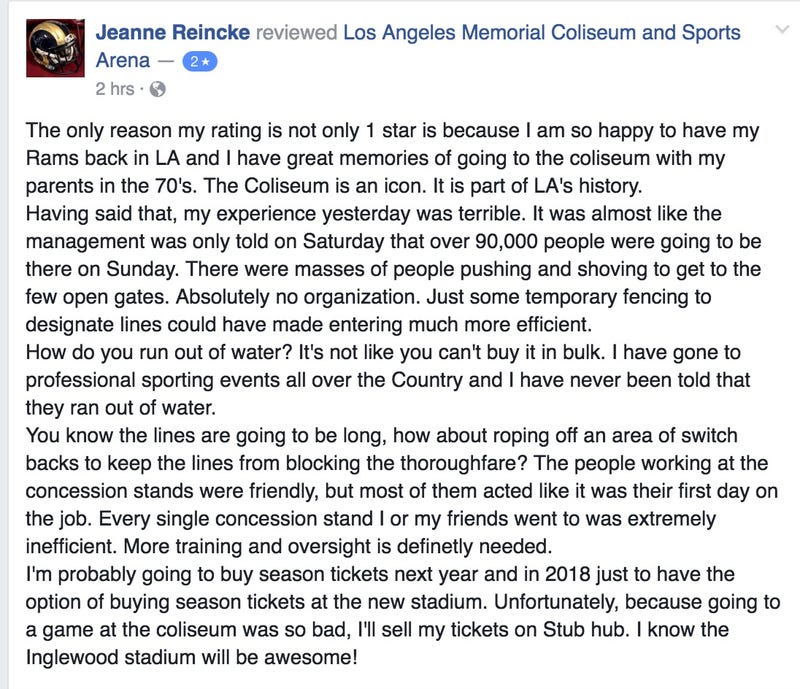
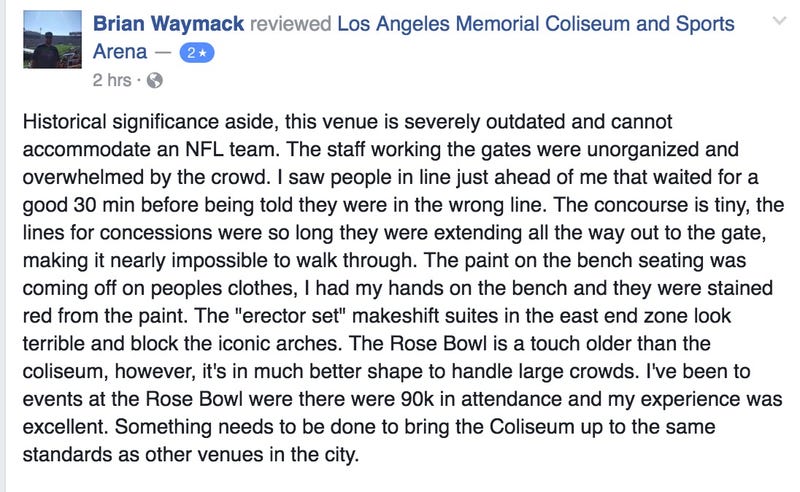
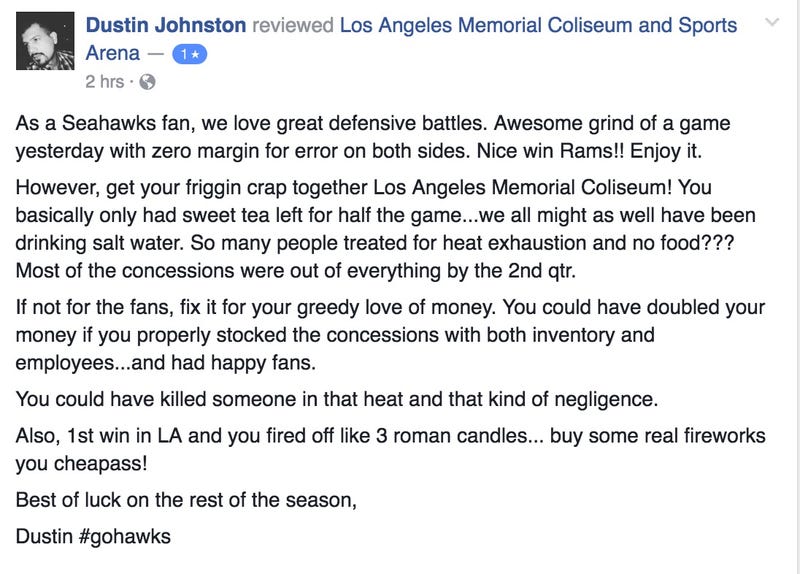

http://deadspin.com/the-fan-experience-at-the-rams-stadium-sounded-like-hel-1786826307The Los Angeles Times reported that 160 people were treated for heat-related problems and 14 people were taken to the hospital during Sundays Rams/Seahawks game at the Coliseum. There are more reviews echoing the same points and complaining about missing entire quarters just to wait in line to not get water.
A silver lining for the fans, however: The game was dogshit and nothing cool happened.
Livingskeletons
If I pulled that off, would you die?
Ah the good old heat stroke Colosseum.
Tatsumaki Senpuukyaku!
Member
Why is that one endzone in the LA coliseum never occupied? They don't fill it up at USC games either.
SirClinksAlot
Member
Classic stadiums > overdesigned ones
Have you ever actually been to the coliseum? Its a dump. I mean, its really fucking old so its no surprise but its not an enjoyable place to watch sports anymore.
Grover Cleveland
Member
The Coliseum = Dump
O.Co = Dump
Candlestick = Dump
Don't confuse classic with...good
I'm not with the Falcons playing in a origami sculpture or the Vikings playing in Star Destroyer remains and I'm certainly not a fan of how overpriced these stadiums have gotten (especially when the owners are still able to hoodwink Joe Taxpayer into financing them), but don't act like these old shitholes are not old shitholes just because they played a few "good" games there over the years.
O.Co = Dump
Candlestick = Dump
Don't confuse classic with...good
I'm not with the Falcons playing in a origami sculpture or the Vikings playing in Star Destroyer remains and I'm certainly not a fan of how overpriced these stadiums have gotten (especially when the owners are still able to hoodwink Joe Taxpayer into financing them), but don't act like these old shitholes are not old shitholes just because they played a few "good" games there over the years.
Have you ever actually been to the coliseum? Its a dump. I mean, its really fucking old so its no surprise but its not an enjoyable place to watch sports anymore.
functionally i'd assume it's not nice. visually is what i prefer.
All the new ones look pretty much the same on the inside, which is part of the point these days. Happened to baseball stadiums too.
Tatsumaki Senpuukyaku!
Member
The Coliseum = Dump
O.Co = Dump
Candlestick = Dump
Don't confuse classic with...good
I'm not with the Falcons playing in a origami sculpture or the Vikings playing in Star Destroyer remains and I'm certainly not a fan of how overpriced these stadiums have gotten (especially when the owners are still able to hoodwink Joe Taxpayer into financing them), but don't act like these old shitholes are not old shitholes just because they played a few "good" games there over the years.
Lambeau Field and the Superdome are pretty good examples of older stadiums that are still nice because they put money into keeping them renovated instead of building newer stadiums.
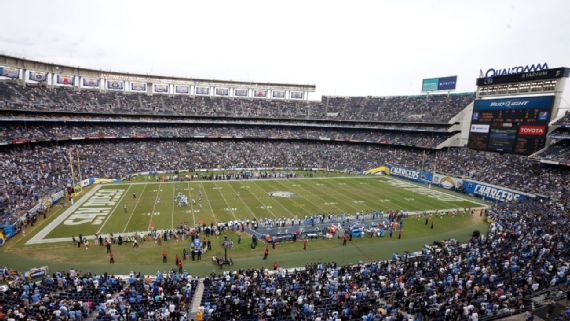
http://www.espn.com/nfl/story/_/id/...rs-exercise-team-option-move-los-angeles-2017Barring a miracle, the San Diego Chargers are expected to exercise the team's option to move to Los Angeles in 2017, sources told ESPN's Jim Trotter.
During the NFL owners meetings in January, in which the league approved the relocation of the Rams to Los Angeles, the Chargers were granted the option to relocate to L.A. with a deadline of Jan. 15, 2017.
Chargers chairman Dean Spanos has to alert the league that he intends to exercise that option by next month's deadline.
The Chargers received only 43 percent approval on Measure C in November. The team's $1.8 billion plan proposed raising hotel taxes from 12.5 percent to 16.5 percent to secure $1.15 billion in bonds to help pay for the stadium project.
The citizens' ballot initiative required two-thirds of the voting public within city limits to approve the project, an extremely high bar for the team to reach.
"Dean has said that he wants everyone to be able to focus on the remainder of the Chargers' season, and so [he] won't be making any final decisions until after the season is over," said Mark Fabiani, the point person on the stadium situation for the Chargers. "That hasn't changed."
The Chargers have a tenant-lease agreement with Rams owner Stan Kroenke that lowers the team's risk because they do not have to borrow money for construction of the $2.6 billion project.
The Rams and Chargers would jointly share revenue such as naming rights, suites, sponsors and advertising. The teams would be on their own to sell season tickets and personal seat licenses.
Kroenke has motivation to complete a deal with the Chargers, because he cannot begin selling personal seat licenses until reaching a decision on whether the Chargers or Raiders will relocate to Los Angeles.
However, the risk for Spanos is that the franchise would be on the hook for a $650 million relocation fee paid over 10 years, determined during the January owners meeting in Houston.
The Chargers also would have to purchase land and construct a practice facility, which would cost tens of millions of dollars.
NFL owners discussed the Raiders moving to Las Vegas during a committee meeting in New York in November. Raiders owner Mark Davis has told the league he plans on filing for relocation to move his franchise to Las Vegas in January.
The Raiders' and the Chargers' stadium situations will be up for discussion at a December NFL owners meeting in Dallas.
New thread for new news, no? C'mon
"C'mon" what?
Given how unreliable rumors about relocation have been in general over the past year or two (shit, there were contradictory rumors even during the owners' meeting itself in which the Rams were voted to move), my thought was to wait until the Chargers officially exercise their option before starting a new thread.
STOP OPENING THIS WOUND
I don't blame RBH for anything, but god damn, even seeing this thread always tends to make me salty as fuck and I thought I was over it.
Vincent Bonsignore
‏@DailyNewsVinny
FYI: According to multiple sources #Chargers considering rebranding if they move to L.A.
@DailyNewsVinny
High-ranking #NFL executive: "#Chargers hoping for a miracle in San Diego but resigned to moving to Los Angeles (in 2017) if not" 1/2
2/2 Another high-ranking #NFL executive: "That (San Diego) miracle has to happen in about a week"
‏@DailyNewsVinny
FYI: According to multiple sources #Chargers considering rebranding if they move to L.A.
@DailyNewsVinny
High-ranking #NFL executive: "#Chargers hoping for a miracle in San Diego but resigned to moving to Los Angeles (in 2017) if not" 1/2
2/2 Another high-ranking #NFL executive: "That (San Diego) miracle has to happen in about a week"
- Status
- Not open for further replies.

